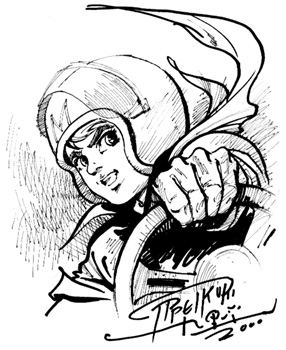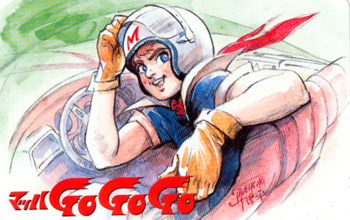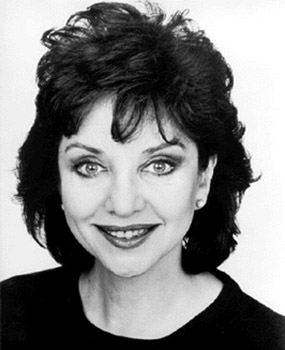Part 1: Go Speed Go! A Series Overview Part 2: Racers Start Your Engines! How it All Began Part 3: MACH GO GO GO Comes to the U.S. Author: James Long One problem that Tatsunoko Productions faced during the production of MACH GO GO GO was the budget. By switching to color, the cost of each episode nearly doubled from that of an episode of SPACE ACE. A single episode of SPACE ACE cost roughly 1,800,000 yen, while an episode of MACH GO GO GO would run about 3,500,000 yen (Approximately $4,970 per episode compared to $9,660 per episode, at 1967 exchange rates). The money from sponsors helped to cover much of the deficit, but not all of it. For additional financial support, the Yoshidas turned to an idea that had been in the back of their minds when developing the series. They looked to sell the series to foreign countries -- America in particular.
At that point in time, there was a small invasion of America being carried out by anime programs. Mushi Productions had successfully exported MIGHTY ATOM, WONDER 3 and JUNGLE EMPORER, which appeared under new American names as ASTROBOY, AMAZING 3 and KIMBA THE WHITE LION. TCJ, another Japanese animation studio, had also seen success with 8 MAN and IRON MAN 28 seen in America as 8TH MAN and GIGANTOR. Like Mushi and TCJ, Tatsunoko wanted very much to have their series shown in America. An attempt had been made to sell SPACE ACE, but it got no further than an English language pilot episode. Fortunately, MACH GO GO GO was destined to have more success. Since Tatsunoko didn’t have the international business experience required to properly promote and sell MACH GO GO GO overseas, they used K. Fujita Associates to handle those arrangements. K. Fujita had done similar work with other Japanese TV series, including selling the live action NINJA SQUAD GEKKO series to Australia as PHANTOM AGENTS. Incidentally GEKKO was based off of a comic created by Tatsuo Yoshida, Boys Ninja Squad Gekko. MACH GO GO GO caught the attention of Trans-Lux Television, a company that syndicated TV series across America. Trans-Lux had previously handled the distribution of such series as THE MIGHTY HERCULES and FELIX THE CAT. They even had past experience with Japanese shows, as they had been the company responsible for importing IRON MAN 28 from Japan and releasing it as GIGANTOR. As Trans-Lux was set up for syndicating TV series, not producing them, they hired an outside firm, Zavala-Riss Productions, to handle the editing and dubbing required to ready MACH GO GO GO for broadcast in America. To oversee the production, Zavala-Riss hired a gentleman named Peter Fernandez. Fernandez had experience preparing Japanese productions for release in the U.S., including work on several of the Toho monster films. He had even worked with anime programs, as Fernandez was one of the writers who had written the English dubbing scripts for both ASTROBOY and GIGANTOR.
Fernandez was given great liberty to "Americanize" the Japanese series. Fortunately, he was helped more than a little by the Western-style atmosphere in MACH GO GO GO, an influence from the American comics enjoyed the by Yoshidas in their youth. In fact, the Mifune family itself had been based of the image of the stereotypical American family. So, while some light editing might be needed, the majority of the MACH GO GO GO episodes could be left intact. One thing that did need changing was the characters names. Go Mifune and Michi Shimura simply wouldn’t fly on American TV in the 1960s. So, while their adventures and relationships would be left unchanged, they were going to have to be called something different. During that period, it was quite common for characters in animated series to be given "descriptive" names. As a result, 8TH MAN had Professor Genius, ASTROBOY had Mr. Pompous, and GIGANTOR had Inspector Blooper. In coming up with new names for the MACH GO GO GO characters, Fernandez followed a similar pattern. The most important name, of course, was that of the series lead. Fortunately, his profession as a fast race car driver lent itself immediately to the very apt descriptive name of "Speed Racer." It was a catchy name that told you immediately who he was, and also a name that could serve double duty as the memorable name for the series itself. Almost as important was the name of Speed’s car. Go Mifune had driven the Mach, and thanks to the big red "M" on the hood of the car, Mach would remain part of the name. Still, Fernandez felt that the name needed a little more. With a large number 5 painted on the side of the car, the answer to that was fairly simple, as the car became the Mach 5. The other characters would likewise be reborn. The sprite-like Kurio Mifune became Spritle, the chimpanzee Sanpei was renamed Chim-Chim, and the Masked Racer, with a big red ‘X’ on his mask, became simply Racer X. It was a deceptively simple pattern, but one that worked well.
Another part of the job for Peter Fernandez was to prepare the scripts for the series. Fernandez was supplied with translations of the Japanese scripts to work with, but the quality of the translations was quite poor. They were filled with clunky English dialogue that, while it got across the notion of what was being said, it was not written in a form that any native English speaker would use. So it fell to Fernandez to take the essence of what was being said and to craft new dialogue to express the same ideas. Having done the same thing for ASTROBOY and GIGANTOR, Fernandez was a perfect choice for this task. As the Director for the series, it also fell to Fernandez to assemble the voice cast. This was an area of difficulty for Fernandez, because the budget for SPEED RACER only allowed for three actors, each being paid $125.00 per episode. With all of the characters in the series, Fernandez realized that it would be nearly impossible to do the show properly without a minimum of four actors.
Casting one of the actors was fairly easy, as Fernandez chose himself to bring Speed Racer to life. In addition to having an extensive background on the production side of TV and movies, Fernandez had also had a lengthy career as an actor that included voice work in many radio programs and dubbing foreign films, so he certainly had the acting chops to back up his choice for the lead character. He also decided that he would be the voice of Racer X, a decision that proved quite appropriate once Fernandez got into the series and discovered the relationship between Speed and Racer X. For the other roles, Fernandez knew he needed actors who could manage a broad range of voices. To handle all of the female and child roles, Fernandez sought out the talented Corinne Orr. Like Fernandez, the Canadian born Orr had lengthy career doing voice work on radio and television. The two had worked together several times before, both on radio shows and while dubbing foreign films for a company named Titra. From this past work with Orr, Fernandez knew that she was a lady who had the versatility he needed for SPEED RACER.
For the third cast member, Fernandez hired an old friend of his, Jack Curtis. The two had met while working together on a 1940s radio program called COAST TO COAST ON A BUS. While the main focus of Curtis’ career was that of a film editor, Fernandez knew that his gruff voice would be perfect for Pops Racer and the steely Inspector Detector, as well as filling in as an announcer. Even with these multi-talented actors behind him, Fernandez’s concern that the show couldn’t be done properly with only three people quickly proved to be correct. He needed a fourth actor, but the budget wouldn’t pay for it. In desperation, he called up his childhood friend Jack Grimes. Grimes had been an actor since he was a child, performing in plays on Broadway and growing up to be a very busy actor in radio and later on television. Fernandez and Grimes had worked together previously on a series of children’s records for MGM. Fernandez knew that, at that time, Grimes was not working. So Fernandez offered a 50-50 split of the $125.00 he’d receive for his voice work if Grimes would join the cast. At $62.50 apiece, this meant that the pay wasn’t going to be great for either actor, but Grimes agreed to the arrangement, and was soon given the roles of Sparky and Chim-Chim. To help hide that the show actually had four actors when only three were authorized, the credits on the series listed only Jack Grimes, Corinne Orr, and Jack Curtis, with Fernandez purposely leaving himself off the list. Still, he did receive screen credit for some of his work on SPEED RACER, as he was listed in the end credits with "Dialogue Written and Directed by Peter Fernandez."
One often parodied trademark of SPEED RACER was the rapid-fire manner of speaking used by the characters. Much of this was the result of efforts to match the dialogue with the lip movements of the characters on-screen. Often there was more necessary dialogue than the lip movements in the animation would easily allow. In order to get everything in during the short time allotted, the actors had to deliver their lines faster than they normally would. It may have sounded a little unnatural, but it was certainly in keeping with the frenetic pace of the stories! The newly dubbed SPEED RACER premiered in syndication in September of 1967, just five months after MACH GO GO GO first began airing in Japan. Fortunately, the 13 MACH GO GO GO episodes that Tatsunoko had produced in 1966 helped give the SPEED RACER crew a longer lead-time than might normally have been expected when looking at the broadcast dates of the two shows, and even resulted in a 1966 copyright notice on the opening credits of SPEED RACER. SPEED RACER was immediately popular with kids, and would remain so for quite some time. Just as in Japan, American kids were fascinated by the thrilling adventures of Speed and his family, the exotic locations around the world to which they traveled, and the exciting races which Speed took part in. Thanks to Fernandez’s successful efforts to "Americanize" the series, many of the young American viewers did not initially realize that the series was made in Japan, despite the handful of Japanese names in the ending credits. Not that it would have mattered if they had, since all most kids cared was that the show was fun to watch!
Another aspect of SPEED RACER that proved to be just as popular as its Japanese counterpart was the opening theme song. That song, titled " Go, Speed Racer, Go," utilized the same melody as the MACH GO GO GO opening theme song, with a new arrangement by musician Billy Mure and catchy English lyrics written by Peter Fernandez. The song was produced by country musician Danny Davis, and sung by Davis, Mure, Don Burkhimer, who was Davis’ boss at the time, and Janet Lederman, who was Burkhimer’s secretary. Production on SPEED RACER continued into 1968, until all 52 episodes of MACH GO GO GO had been reworked for American television. As the cast and crew who had created the series went their separate ways, the result of their labors would soon become a popular fixture on the broadcast landscape. As time went by, there were a number of significant changes going on behind the scenes that involved SPEED RACER, not that these would be readily apparent to people watching the series at home. In 1969, Trans-Lux decided to get out of the TV syndication business. Their entire catalog of programs were bought by Alan Gleitsman, whose company, Alan Enterprises, continued to syndicate SPEED RACER well into the 1970s. Unfortunately, the series’ time in the syndication market was cut short when it became a target for the various child welfare groups, many of which felt SPEED RACER was too violent a program for kids. Though the series was still popular with kids, a number of TV stations pulled it from their line-ups in order to avoid the complaints from these pressure groups. By the early 1980s, SPEED RACER could only be found airing sporadically around the country. In 1986, Alan Enterprises left the syndication business when the company was bought out by Color Systems Technology, a group known best for their efforts to digitally add color to black and white movies. Though the rights for SPEED RACER went along with the deal, CST was mostly interested in the black and white movies in the Alan Enterprises library. But the colorization craze did not last very long, and Color Systems Technology found itself bankrupt by 1989.
To help pay the debts owed by CST, the rights to their library of films and TV shows were sold at auction. At that time, the rights for SPEED RACER ended up being split between two companies, Broadway Video and Caputo Publishing. Broadway Video eventually made arrangements with the VidAmerica company to release the episodes they owned on VHS, making episodes of SPEED RACER available on home video for the first time. In 1987, Caputo Publishing used their Now Comics label to produce a new Speed Racer comic, a first for the American version of the series. As the market for importing and translating Japanese comics began to grow in the late 1980s, Now Comics even published a portion of the Tatsuo Yoshida Mach Go Go Go comic in English to accompany their Speed Racer comic. The success of the comics and the videos proved that there was a market SPEED RACER merchandise. By that time, the kids who had watched the adventures of Speed and the Mach 5 as children were now adults, and SPEED RACER was a nostalgic part of their past that many longed to recapture. Seeing this, John Rocknowski realized the huge untapped potential SPEED RACER held. During the 1980s, Rocknowski had worked at Harmony Gold, the TV distribution company that produced ROBOTECH. ROBOTECH was created from three anime series, MACROSS, SOUTHERN CROSS and MOSPEADA, all three of which were created or distributed by Tatsunoko Productions. Thanks to the relationship with Tatsunoko that Rocknowski had developed during his time at Harmony Gold, he was able to strike a deal with Tatsunoko to obtain the rights to SPEED RACER when the license came up for renewal in 1991.
Wasting no time, Rocknowski was joined by his son Jim in forming Speed Racer Enterprises, a company dedicated to managing SPEED RACER and its characters. Before long, Speed Racer Enterprises had made arrangements with numerous companies to get a variety of SPEED RACER items onto store shelves, leading to an explosion of SPEED RACER merchandise that has continued to this day. With the growing public awareness of SPEED RACER, the character found himself in the unusual position of being a commercial pitchman. In 1996, ESPN ran a series of humorous ads featuring Speed and the Mach 5 to help promote NASCAR racing. 1996 also saw Speed Racer in a new animated commercial where Speed had to drive a Volkswagon GTI in order to win a race. More recently, Speed, Trixie, Spritle, and Chim-Chim could be seen in a 2004 commercial for Geico auto insurance. One of the most important things that Speed Racer Enterprises did was to finally get the series back on the air. SPEED RACER had left the syndication market entirely during the time Color Systems Technology owned the rights, and the series was unavailable to the majority of its potential audience, except for the few episodes that had been released on home video.
In 1993, SPEED RACER found a new television home. This time it wasn’t in syndication, but instead on the cable channel MTV, where it captured the attention of a younger audience who had never been exposed to the series before. This was followed in 1996 by SPEED RACER moving to a spot on the Cartoon Network, and eventually moving to its sister network, Boomerang. In 2005, SPEED RACER briefly made its way to the aptly named Speed Channel, a network dedicated to all forms of car racing. While all of the episodes of SPEED RACER have finally been released to the home video market, this classic series is currently not being shown on television. Considering the history of the show, it’s probably safe to assume that this is only a temporary situation, and that, sooner or later, Speed Racer will once more be "...off and flyin’ as he guns his car around the track!" Bonus Images! Close up from Mach GoGoGo Pachinko game. Full Shot of Speed from the Pachinko game. Racer X from the Mach GoGoGo Pachinko game. Close up of Speed from the Mach GoGoGo Playstation game. Full shot of Speed from the Mach GoGoGo Playstation game. To Be Continued!! Keep checking back to SciFi Japan as we continue our in-depth look at the original SPEED RACER cartoon and the new SPEED RACER movie coming to a theater near you May 9, 2008 from Warner Brothers!












